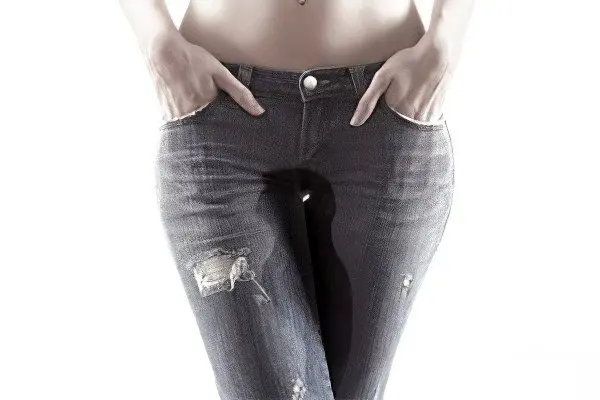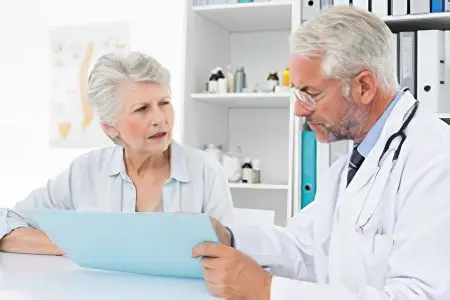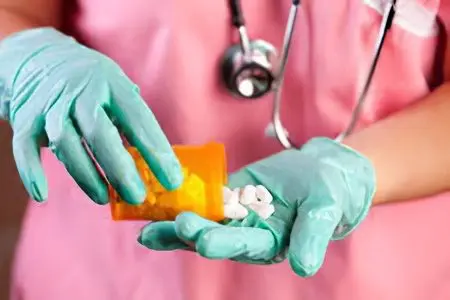Contents

Urgent urinary incontinence is an unbearable urge to urinate that cannot be restrained by willpower. This type of urinary incontinence is also called urge incontinence. Its cause lies in an overactive bladder.
Normally, the urge to urinate occurs after a sufficient amount of urine accumulates in the cavity of the organ. Feeling this urge, the person goes to the restroom, where he empties his bladder. When the reactivity of the bladder is increased, even a small amount of urine is enough for a woman to have an unbearable urge to urinate. In the event that there is no toilet nearby, then the risk of missing urine will be very high.
Imperative incontinence is also called the imperative urge to empty the bladder, which is almost impossible to cope with willpower. Meanwhile, urge incontinence is a problem that requires treatment. It should not be ignored, as it significantly worsens the quality of a person’s life: he is constantly in need of looking for a toilet, experiences discomfort, is forced to wear pads to avoid the appearance of an unpleasant odor.
The prevalence of urge urinary incontinence among women, according to various sources, is 11-20%. Most often, older women suffer from it. However, you should not put up with this problem. It can and should be fought against, especially since modern medicine has all the possibilities for this.
Causes of urge urinary incontinence

The main cause of urge urinary incontinence is an overactive bladder. The human psyche has increased excitability, which leads to a faster transmission of impulses to the muscles of the sphincter and bladder. As a result, the body will react even to a slight irritation.
It becomes especially difficult to hold urine when there is some external irritant nearby, for example, water is pouring, a bright light is on, a sharp sound occurs, etc. Imperative urges will occur even when very little fluid has accumulated in the organ.
Prerequisites for the development of imperative urinary incontinence can be obesity, sudden weight loss, difficult working conditions, a tendency to constipation, undergoing radiation therapy, and difficult childbirth.
Violation of the connections between pressure receptors in the bladder and brain structures that are responsible for conscious urination can be due to factors such as:
Age-related dystrophic changes in the nervous system;
Hormonal disorders;
Past injuries and surgeries;
The presence of tumor processes;
Frequent infectious and inflammatory diseases of the urogenital area;
Climax.
As a result of such damage, the signal about the urine accumulated in the organ enters the brain too early, and it is pathologically enhanced. The muscular wall of the bladder begins to contract, the sphincter opens, urine flows out through the urethra.
Symptoms of urge urinary incontinence

Symptoms of urge urinary incontinence include:
Frequent urge to empty the bladder (pollakiuria). A woman can go to the toilet more than 8 times a day. At night, she may get up to urinate two or more times.
The urge to void will almost always be unexpected.
The urge to urinate will be strong and difficult to contain.
The urge to empty the bladder occurs against the background of external stimuli.
When imperative urinary incontinence is accompanied by prolapse of the bladder, pain in the lower abdomen is not uncommon. There may be a feeling of incomplete emptying of the bladder or a feeling of a foreign object in the vagina.
During or after sexual intercourse, there may be a feeling of discomfort or pain in the pelvic area.
Regular leakage of urine provokes the occurrence of dermatitis in the inguinal zone, promotes the growth of bacteria, the recurrence of urogenital infections, including: cystitis, vulvovaginitis, pyelonephritis.
The discomfort that a woman experiences against the background of imperative urinary incontinence affects her neuropsychic state. Patients become prone to depression and neuroses.
Distinctive features of imperative and stress urinary incontinence:
Symptoms | urge incontinence | stress incontinence |
The urge to void to urinate is imperative | Yes | No |
The number of urination per knock exceeds 8 times | Yes | No |
Urine is excreted against the background of laughter, coughing, any physical activity | No | Yes |
Portion of urine | Plentiful | Small portions |
Night awakenings to empty the bladder | Yes | No or very rarely |
The ability to resist the urge | No | There is |
Diagnosis of imperative urinary incontinence

To identify a woman with imperative urinary incontinence, the following examinations are shown:
Cough test. In the gynecologist’s office, a woman is asked to cough while her bladder is full. This allows you to distinguish between urge and stress incontinence.
Urination diary. In it, a woman for several days writes down the amount of liquid that she drinks, the number of trips to the restroom, the volume of urine excreted. It is important to take into account the volumes of urine that are released during involuntary emptying of the organ. You should also pay attention to the situations in which urinary incontinence occurs.
Cystoscopy will be required to exclude bladder pathology, such as a tumor, the presence of stones, ulcers or inflammation. This study is an examination of the organ by inserting a microscopic endoscope into it. Access is through the urethra.
Comprehensive urodynamic examination indicated to determine the cause of urge urinary incontinence.
Possibility of an ultrasound bladder and pelvic organs.
To exclude infection, urine is taken for general and bacterial analysis.
Of course, that any visit to the doctor begins with the collection of anamnesis. To find out the cause of urinary incontinence and get quality treatment, a woman will need to visit not only a urologist, but also a gynecologist.
Treatment of urge urinary incontinence

Urge incontinence is not treated with surgery. It is recommended that all patients with this problem first of all try to get rid of the existing problem with the help of a non-drug correction program.
General Treatments
If a woman is overweight, then she needs to get rid of it. It leads to an increase in pressure on the bladder, disrupts the normal arrangement of organs. Therefore, without correction of body weight, it will not be possible to get rid of urinary incontinence.
Diet. To reduce the severity of symptoms of imperative urinary incontinence, a decrease in the consumption of tea, coffee and other drinks containing caffeine is shown. If this is not done, then the risk of missing urine increases. The fact is that all caffeinated products have a diuretic effect. As for limiting fluid intake, if the doctor did not give such recommendations, then you need to drink at least 1,5 liters of water per day.
You should set the mode of urination. It is necessary to try to visit the toilet during the hours strictly allotted for this event, no matter how strong the urge is. You need to start with small intervals of half an hour, gradually bringing them up to an hour or more. Over time, such training will certainly give the desired result.
You need to train your pelvic floor muscles. This will bring them into tone, restore the function of the sphincter, if it was slightly lost. The better a woman controls the sphincter muscles, the easier it will be for her to restrain imperative urges.
Well proven in terms of training the muscles of the pelvic floor, Kegel exercises. It is necessary to strain and loosen them at least three times a day, keeping the muscles in good shape for at least 3 seconds. It is worth noting that training can be carried out almost anywhere, since it is invisible to others. When the muscles come into tone, the exercises can be diversified by performing them in a different rhythm, doing push-ups (as with attempts during childbirth), etc.
Another effective method of dealing with imperative urinary incontinence is biofeedback training. It is aimed at working out the pelvic muscles, but in this case, the force of their contraction is controlled by special equipment. If necessary, you can use electrical muscle stimulation. Biofeedback therapy has been proven to tone muscles and achieve maximum control over urination.
Modern medicine offers women a huge variety of simulators that are compact in size and allow you to tone the internal muscles of the pelvis.
Psychological training in combination with other methods of non-drug correction is effective for imperative urinary incontinence. When strong urges arise, you need to try to distract yourself as much as possible. For example, you can reflect on your upcoming plans for the day, read an interesting article, etc. The most important task facing a person is to distract from thoughts about going to the toilet for a while.
Medication

If general methods of treatment do not bring the desired result, then you can try to get rid of imperative urinary incontinence with the help of medical correction. For this, women are prescribed:
Drugs aimed at reducing the increased tone of the bladder wall. These are drugs such as: Detrusitol, Driptan, Vezikar, etc.
To relax the bladder during its filling and improve its blood supply will help drugs such as: Omnic, Caldera, Dalfaz.
If urge incontinence is a consequence of menopause, then hormone therapy may be prescribed. Hormones can be used both in the form of tablets and in the form of ointments.
It should be understood that the treatment of urge urinary incontinence in women is a complex task that requires an integrated approach. However, the problem cannot be ignored. Urinary incontinence is extremely common, so don’t hesitate to seek help from your doctor. He will prescribe special medications that will significantly improve the quality of life.
Prevention

In order to prevent the occurrence of imperative urinary incontinence as long as possible, you need to use the following simple recommendations:
An adult should drink at least 1,5 liters of pure water per day. Drinking too much and too little should not be done, as this can be harmful to health.
Be sure to control your own weight. If you can’t cope with extra pounds on your own, then you need to contact a specialist.
It is important to give up bad habits.
It is necessary to control the timely emptying of the intestine, to prevent the occurrence of constipation.
Strengthening the pelvic muscles is necessary throughout life, and not just when the problem of incontinence arises.
It is desirable to create an individual mode of urination. It is difficult to train yourself to go to the restroom by the hour, but it is quite possible. This is an excellent method of preventing urge urinary incontinence.
Urge incontinence is a serious problem that requires professional treatment. Therefore, it is important to seek help from a specialist, and not suffer from false shame and discomfort.









